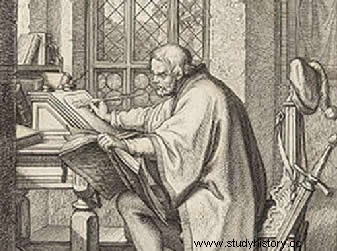
The religious movements that culminated in the great religious reform of the century XVI began in the Middle Ages, through theologians John Wycliffe and Jan Huss. These movements were repressed, but in England and Bohemia (now the Czech Republic), reformist ideals persevered in circumstances hidden from the trends that broke up the religious revolt in Germany.
In the beginning century, the Church was going through a delicate period. The sale of ecclesiastical offices and indulgences and the weakening of papal influences by the growing prestige of European sovereigns, who often directly influenced Church decisions, provided an opportune environment for a reform movement.
At the end of the Middle Ages a strong nationalist spirit emerged that developed in several countries where the figure of the Church, that is, the Pope, was already in disrepute. This nationalist spirit was strategically exploited by princes and monarchs, bent on increasing monarchical powers, placing the Church in a situation of subordination.
During this period, eyes turned to the great patrimony of the Church, which aroused the ambition of monarchs and nobles eager to annex to their lands the great and rich properties of the Church, which made up a third of the territory of Germany and a fifth of the territory of France. Not to mention the tax exemption on this ecclesiastical territory, which increased the interest of the wealthiest.
At this stage a new social class emerged, which in Italy was made up of powerful bankers and merchants. But this social class was not as religious as that of Germany, for which religion had a much more poignant meaning.
The critical spirit of Humanism and the improvement of the press, by Gutemberg, contributed to the diffusion of written works, among them the Bible. By translating the Bible into other languages, the possibility of Christians and non-Christians was envisioned without mediation, receiving immediate knowledge about Christianity and its true practices.
The starting point of religious reform was the attack by Martin Luther , in 1517, to the Church's practice of selling indulgences. Martin Luther was a monk of the Catholic order of Augustinians, born in Eisleben in 1483, Germany. After his first studies, Luther enrolled at the University of Erfurt in 1501, where he graduated in Arts. After spending a few years at the monastery, studying the thought of St. Augustine, he was appointed professor of theology at the University of Wittenberg.
Luther admired the writings and ideas of Jan Huss on Christian freedom and the need to bring the Christian world back to the simplicity of the life of the first apostles. Through exhaustive study, Luther found answers to his doubts and, from that moment, began to defend The doctrine of salvation by faith . He drafted 95 theses that harshly criticized the purchase of indulgences. Here are some of them:
- Thesis 21 - Those who preach indulgences and claim to their neighbor that he will be freed and saved from all punishment for sins committed through the Pope's indulgence are wrong.
- Thesis 36 - Every Christian who truly repents of his sins and feels regret for having sinned has full forgiveness of sins and consequently of his debts, even without the letter of indulgence.
- Thesis 43 - Christians should be taught that he who gives to the poor or lends to those in need does better than buying indulgences.
These principles were considered an affront to the Catholic Church. In 1521, the Augustinian monk, already declared a heretic, was definitively excommunicated by the Catholic Church, taking refuge in Saxony. Luther did not intend to divide the Christian people, but the repercussion of his theses was widespread; and his ideas, passed on. Through the translation of the Bible into the German language, the number of adherents to Luther's ideas greatly increased; and, on the other hand, the power of the Church has diminished considerably.
His religious reformist ideals unleashed revolts and assumed political and socioeconomic dimensions that escaped his control. Social revolt took hold and discontent was general. The princes took over the lands belonging to the Catholic Church and the peasants revolted in 1524 against the exploitation of the Church and the princes. Luther, who was protected by the princes, condemned the revolt of the peasants and the radical Protestant leader, Thomaz Munzer. Munzer was beheaded and a large number of revolting peasants were massacred by armies organized by local princes supported by Luther, who said “there is nothing more harmful than a revolted man... ”.
Luther's concern to defend feudal aspirations made his doctrine considered a religion, the religion of the nobles. These nobles held important positions in the Church, which was called the Lutheran Church. Luther's religious reform reached other countries, such as Denmark, Sweden, Norway, which were breaking ties with the Catholic Church, promoting the reorganization of new religious doctrines.
